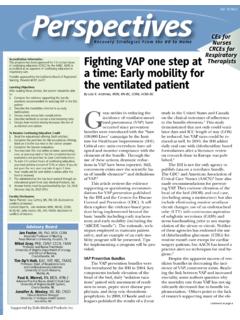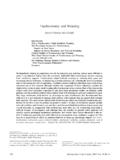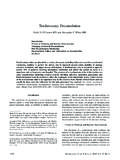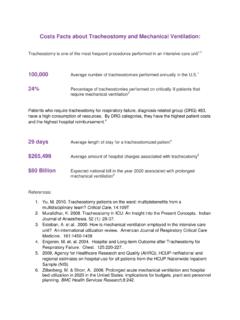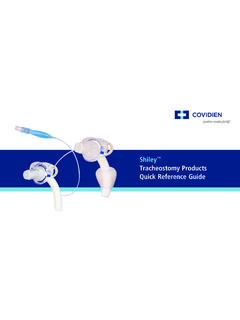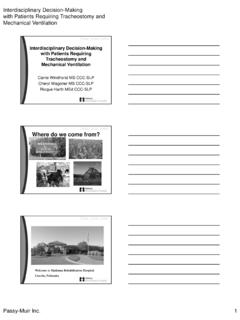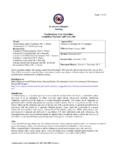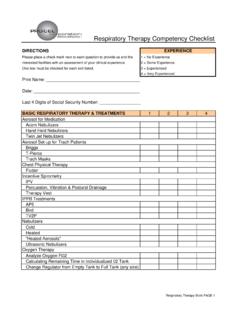Transcription of ABSTRACT Ventilator-Associated Pneumonia and …
1 Vol. 9, Recovery Strategies from the OR to Home ABSTRACT Ventilator-Associated V. Pneumonia and entilator- associated Pneumonia (VAP). is defined as a lower respiratory tract infection occurring at least 2 days CRCE's for tracheostomy after beginning mechanical ventilation. The Respiratory Therapists estimated associated mortality rate is 24% to CEUs for Nurses 50%. Because VAP is prevalent in ICU patients on mechanical ventilation, numerous studies Charles G. Durbin Jr, MD, FCCM, FAARC. V. have been undertaken to determine ways to decrease its incidence. One area of study sur- entilator- associated Pneumonia receive prolonged mechanical ventilation rounds the utility of early tracheostomy as a de- (VAP) is defined as a lower respira- ( 14 days) (4) lack of a standard definition tory tract infection occurring at least of early versus late tracheostomy or an terrent to VAP.
2 The association of tracheostomy 2 days after beginning mechanical optimal technique for doing the procedure, with VAP, the benefits of an early tracesotomy ventilation. While VAP is named for its asso- (5) institutional differences in diagnosing is the purpose of Dr. Durbin's review. ciation with mechanical ventilation, it is be- VAP, (6) differences in weaning methods, lieved to be caused by oral or nasotracheal and (7) varying quality of study design and tracheostomy is an intensive-care measure intubation and only coincidently related to data collection. that requires specialized care and monitoring. mechanical ventilation. VAP is considered Whether VAP contributes to increased Despite its potential for reducing ventilator - to be clinically significant with an estimated risk of death remains debatable.
3 However, associated Pneumonia , it has its own risks, associated mortality rate of 24% to 50%.1 In we know unequivocally that VAP prolongs which are minimized by careful attention addition to increasing the likelihood of death the duration of mechanical ventilation, in the ICU or hospital,2 VAP survivors have lengthens the ICU stay, and increases health- to device and patient care. In this issue of a reduced life expectancy after hospital dis- care consumption. One component of this is Perspectives, we have assembled a panel of charge. For example, a study by Ranes re- the direct cost of antimicrobial therapy, as experts to discuss trach care, strategies to vealed that of survivors of VAP were antibiotic consumption is 10 times greater in minimize morbidity and mortality in this pa- dead 1 year later, and survived no ICUs than in general hospital care A.
4 Tient population, patient and family education, more than 5 2003 cost analysis by Warren and colleagues5. In a study from the Netherlands, 92% of showed that each case of VAP was associ- and decisions regarding weaning and decan- all bacteriologically proven infections in the ated with an additional direct cost of almost nulation. Differences in adult versus pediatric 2 ICUs studied occurred in intubated pa- $12,000. Thus, prevention of VAP can posi- populations are also highlighted. tients; 71% of those infections were deemed tively affect clinical and financial outcomes. Because VAP is prevalent in The association of tracheostomy with Advisory Board ICU patients on mechanical ventilation, nu- VAP is the purpose of this review.
5 Mechani- merous studies have been undertaken to de- cal ventilation is known to be associated Lois Dixon, MSN, RN termine ways to decrease its incidence. One with infections, including local wound infec- Adjunct Faculty, Trinity College of Nursing, Moline, IL area of study surrounds the utility of early tions, VAP, and Because trans- Pulmonary Staff Nurse, Genesis Medical Center, Davenport, IA. tracheostomy as a deterrent to VAP. laryngeal tubes provide a direct conduit to Jan Foster, RN, PhD, MSN, CCRN Benefits of early tracheostomy cited in the lower airway and are often colonized Associate Professor of Nursing Texas Woman's University, Houston, TX various studies include (1) shorter ICU and with pathogenic organisms, replacing a hospital stays, (2) lower incidence of VAP, translaryngeal tube with a tracheostomy Mikel Gray, PhD, CUNP, CCCN, FAAN.
6 Professor and Nurse Practitioner, University of Virginia and, in some cases, (3) decreased mortal- removes the direct pathway from the mouth Department of Urology and School of Nursing, ity and (4) shorter weaning times. However, to the lung, potentially protecting the patient Charlottesville, VA. these outcomes vary by study design and from VAP. Tracey Hotta, RN, BScN, CPSN ICU patient population, making results dif- Past President, American Society of Plastic Surgery Nurses Toronto, Ont., Canada ficult to interpret and apply. Studies of early Etiology of VAP. tracheostomy must grapple with a great Prevention of VAP requires understand- Tim Op't Holt, EdD, RRT, AEC, FAARC amount of heterogeneity, including (1) dif- Professor, Dept.
7 Of Respiratory Care and Cardiopulmonary Sciences ing of how it develops. The prevailing theory University of South Alabama, ferent patient populations, (2) presence of is that bacteria from the mouth and upper Mobile, AL different underlying diseases or multi-organ respiratory tract gain entrance into the low- Victoria Base-Smith, PhD(c), MSN, CRNA, CCRN damage that could confound results, (3) dif- er respiratory tract via the artificial airway. Clinical Assistant Professor, Nurse Anesthesia, ficulties predicting which patients need to University of Cincinnati, OH Continued on page 4. Supported by an educational grant from Dale Medical Products Inc. Panel Discussion: Care of decannulation or trach tube malfunction.
8 What can be done to mitigate the conse- quences of this in the ICU? In the general tracheostomy Tubes and ward? Cahill: Prevention starts with recognizing Trach Patients high-risk patients, which includes infants and patients with altered mentation, then closing monitoring those patients. Continu- Moderator: Charles Durbin, MD ous and remotely alerted ETCO2 monitoring Panelists: Tom Cahill BHS, RCP, RRT-NPS, EMT-P is useful in detecting accidental decannula- Cynthia White, RRT-NPS, AE-C, FAARC tions quicker than conventional ECG and SPO2 and can help decrease mortality. Core David A. Grooms, MSHS, RRT team members including RTs, RNs, and MDs who are trained to respond to this type of tracheostomy is an intensive-care ity to clear respiratory secretions, and the emergency should consistently follow guide- measure that requires specialized reason for the The risks of common lines in place to mitigate ,10.
9 Care and monitoring. Despite its po- complications of trachs necessitate the need tential for reducing ventilator -associ- for specialized White: Checklists can help ensure patient ated Pneumonia , it has its own risks, safety. A patient with a fresh trach tube is which are minimized by careful at- Durbin: That leads us to our next question. a perfect example of a scenario where a tention to device and patient care. What monitoring is required for new trach checklist could be used successfully to en- The following discussion covers trach patients when they are transferred to a gen- sure all emergency airway equipment is read- care, strategies to minimize morbid- eral floor? ily available,13 along with emergency num- ity and mortality in this patient pop- bers of appropriate personnel to contact.
10 All ulation, patient and family educa- Cahill: All our trach patients are monitored staff who are managing patients with a new tion, and decisions regarding wean- with a minimum of pulse oximetry and ECG trach tube should be trained and checked off ing and decannulation. Differences during naps, procedures, and at night. In ad- on proper care of these ,14 A check- in adult versus pediatric populations dition, I advocate that such patients have list could also be used when training care- are also highlighted. continuous ETCO2 monitoring so staff can be givers to care for patients with trachs. Criti- notified more quickly if accidental decannu- cal paths for care should be defined as well, Durbin: tracheostomy is often performed in lation were to ,10 because patient airway scenarios differ.
